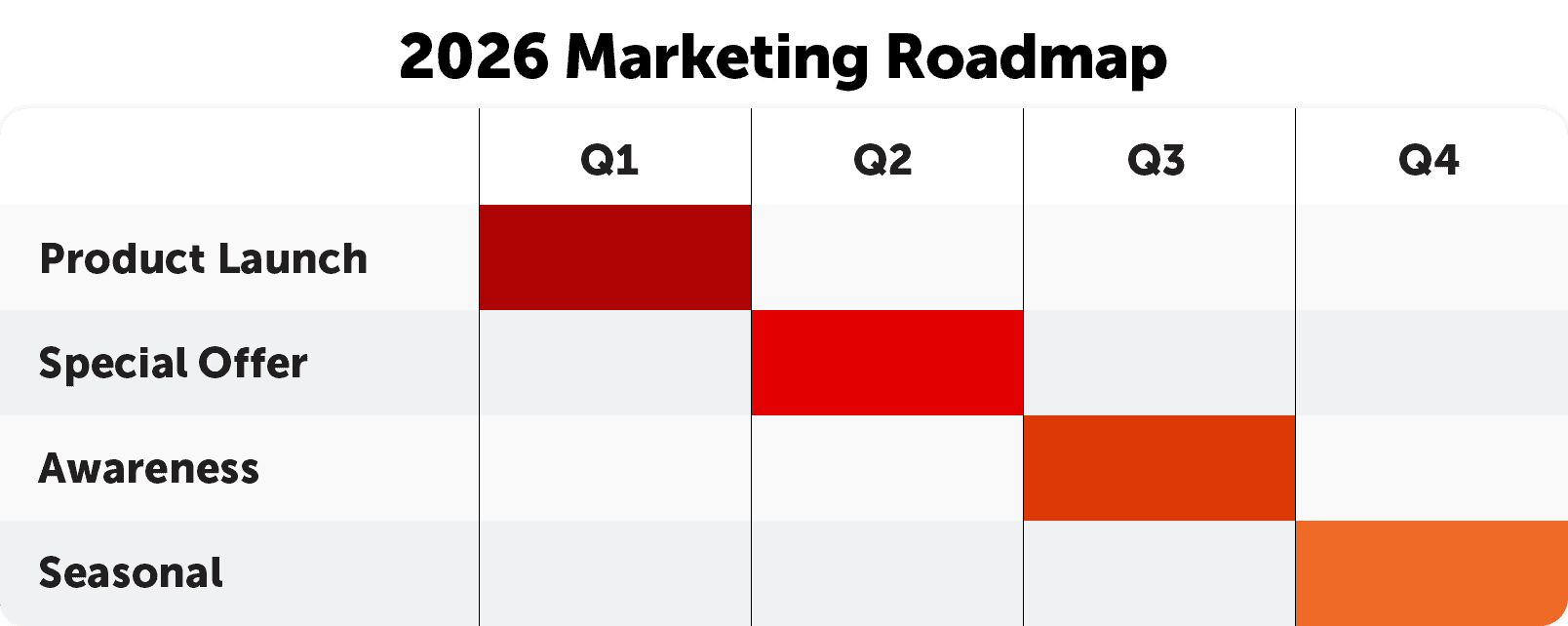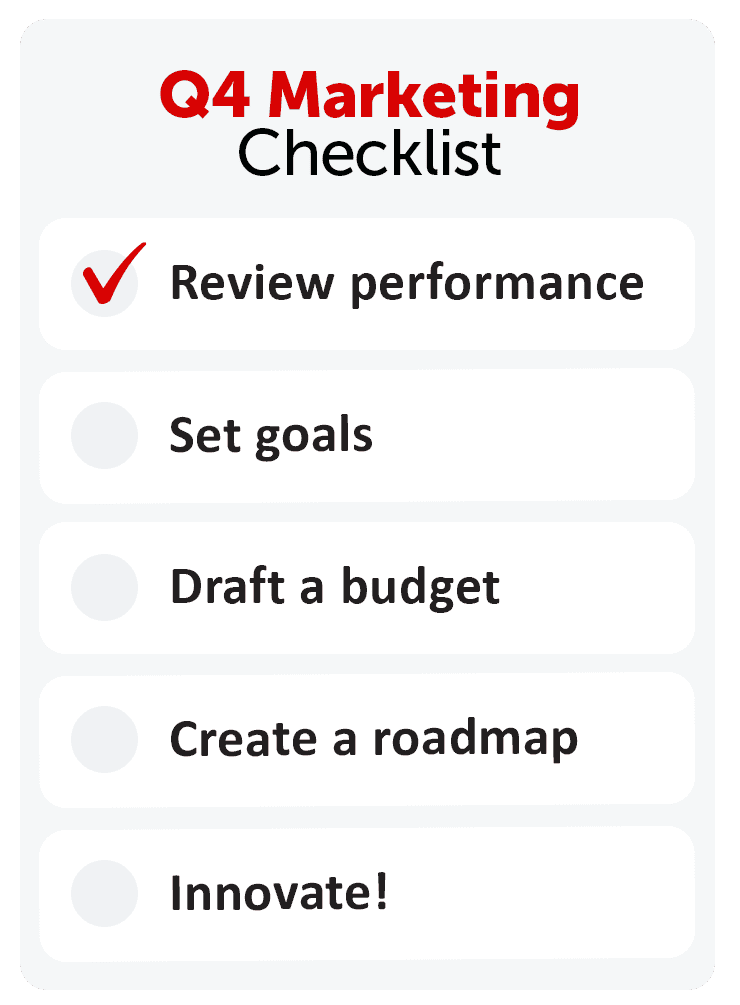Table of Contents
Most teams treat Q4 like a junk drawer stuffed with leftover projects, random clean-up tasks, and the last of the budget. But here’s the truth: Q4 isn’t cleanup duty. It’s your biggest competitive advantage.
The marketers who win next year are the ones who start planning before it begins. This is the moment to sharpen your strategy while everyone else is distracted, to set the stage for January instead of stumbling into it. Spend the next few months reviewing, refining, and aligning—and you won’t just start strong, you’ll start ahead.
This isn’t about scrambling to “wrap things up”. It’s about using the calendar to your advantage. So how do you turn Q4 from catch-up mode into your unfair advantage? Start here.
1. Look Back Before You Move Forward
A busy year isn’t the same as a productive one. If you don’t stop to evaluate what actually worked, you’re just dragging dead weight into next year.
Audit your campaigns, channels, and tactics with a critical eye. Which ones delivered real ROI? Which ones just chewed up time and budget without moving the needle? This isn’t about judgment—it’s about clarity. Once you see the patterns—channels that consistently deliver, audiences that stick, themes that actually resonate—you also see the distractions.
Maybe it’s the newsletter that only ever gets opened by your own team, or the social channel where engagement flatlined a year ago. Maybe it’s that flashy campaign that looked amazing in the pitch deck but barely moved a lead. These patterns show up fast when you stop long enough to look. And once you see them, the question is simple: are you willing to stop feeding the things that don’t feed you back?
Naming those truths now means you set priorities with purpose instead of dragging the same baggage into another year.
Not sure where to start? See how a brand and marketing assessment can help you zoom out, reconnect with your audience, and make sure your goals align with your brand.
2. Set Goals That Pass the “So What?” Test
“Get more followers.” “Post more often.” “Increase sales.” These all sound nice. But so what?
If your goals don’t tie directly to growth, revenue, or retention, they’re just vanity projects dressed up as strategy.
It’s time to swap fuzzy metrics for outcomes that actually matter. “Increase qualified leads by 15%” beats “get more likes” every single time because it connects activity to impact.
Plus, let’s be real—your team can’t chase 15 goals at once. The longer your list, the thinner your focus. Choose a small set of sharp, measurable goals that people can actually rally around. Then, bake in quarterly checkpoints. That way, if something’s not working, you can pivot fast instead of pretending it’s fine until December.
3. Build a Marketing Budget That Works as Hard as You Do
Now that you have your goals, you have to have the budget to back them. But most marketing budgets are ghosts of years past. They’re copied, tweaked, and repeated without asking if they still make sense. That’s not strategy. That’s autopilot.
So how do you fix it? You flip the script. Align your marketing budget with what you want to achieve, not with what you’ve always done. A framework like 70/20/10 is simple but powerful: keep most of your spend on proven plays, dedicate some to emerging strategies, and reserve a slice for true experiments. That balance lets you scale what’s working without closing the door on what’s next.

But alignment only works if it’s realistic. Setting aggressive growth targets while keeping your marketing spend flat—or worse, trimming it—is like expecting a race car to win on an empty tank. Ambition without investment doesn’t scale.
And the secret weapon? Flexibility. Platforms shift, markets change, trends explode out of nowhere. The smartest teams leave breathing room. A reserve fund ready to jump when the right opportunity hits—because it will.
4. Map Out a Roadmap You’ll Actually Use
If your marketing plan is a 50-page binder or an email chain that’s 50+ messages deep, it’s already obsolete. Nobody reads that, and by the time someone does, it’s out of date.
What you need is a roadmap that works in practice: a concise, living document that doesn’t just sit on a shelf but actually guides decisions. At minimum, it should outline your marketing strategy and positioning, map out major campaigns and seasonal pushes on a clear timeline, and flag the industry moments you can’t afford to miss. It should also connect the dots across owned, earned, and paid channels, while making it crystal clear who’s responsible for what—and when.
Think high-level, not overwhelming detail. Maybe Q1 is about a new product launch. Q2 promotes a special offer. Q3 features a general awareness campaign, leaving Q4 to focus on seasonal messaging. Laying this out at a glance helps you see the rhythm of your year and makes sure you’re not stacking three big bets on top of each other in the same month.

And don’t fill every inch of the calendar. Leave white space for the things you can’t predict, such as quick-turn opportunities, industry trends, and cultural moments. The best roadmaps give direction without locking you in. Flexibility is what turns planning into momentum.
5. Keep Innovation on the Radar
So now that you’ve got a roadmap, next comes the question: how do you make sure it doesn’t just lock you into last year’s playbook? That’s where innovation comes in.
The smartest brands treat innovation like a lab experiment. Test, measure, repeat. Emerging platforms, AI tools, new ad formats, influencer plays—they’re all worth a petri dish trial. Not everything will survive, and that’s the point. When something works, you graduate it into your playbook. When it bombs, you pull the plug without wasting another dollar.
And remember, innovation doesn’t always require big budgets. Sometimes it’s as simple as A/B testing subject lines, running a small pilot with a new audience segment, or trying out a fresh creative format. The point isn’t about size. It’s about building the reflexes to pivot faster than the brand next to you.

The Best Time to Start Was Yesterday. The Next Best Time is Now
Next year’s momentum doesn’t start in January. It starts now.
The teams who spend Q4 auditing, goal-setting, budgeting, and roadmapping aren’t scrambling in the new year—they’re already moving.
So pick one thing today—review this year’s performance, set a measurable goal, or draft your marketing budget—and make it happen. Small steps now become the unfair advantage you’ll thank yourself for later.
Need a partner to help shape your 2026 strategy? Let’s talk.
